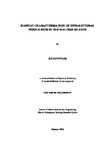Habitat Characterisation of Infralittoral Pebble Beds in the Maltese Islands
| dc.contributor.supervisor | Cotton, Peter A | |
| dc.contributor.author | Evans, Julian | |
| dc.contributor.other | School of Biological and Marine Sciences | en_US |
| dc.date.accessioned | 2014-05-13T15:00:24Z | |
| dc.date.available | 2014-05-13T15:00:24Z | |
| dc.date.issued | 2014 | |
| dc.identifier | 10321284 | en_US |
| dc.identifier.uri | http://hdl.handle.net/10026.1/3012 | |
| dc.description.abstract |
The Mediterranean biocoenosis of infralittoral pebbles has been poorly studied and very little information is available on the physical characteristics of pebble beds, on the diversity of the associated assemblages, on the spatial and temporal variation in assemblage structure, or on interactions between the physical and biotic components. The present study was therefore carried out to characterise pebble-bed assemblages as a first step towards understanding the ecological dynamics of these habitats. Preliminary surveys were made along the low-lying coasts of the Maltese Islands to map the occurrence of pebble-bed habitats. Fifteen locations with pebble coverage >25 m² were chosen for study and benthic sampling was undertaken between July–September 2011; water samples were also collected on a monthly basis. Five shallow sites were sampled for biota again at six-month intervals until April 2013. The pebble beds were characterised in terms of environmental parameters and biotic composition. A total of 62,742 individuals belonging to 360 macrofaunal taxa were recorded (total sampling area: 16 m²). Polychaetes, crustaceans and molluscs were the most common faunal groups. The recorded species included the endemic gastropod Gibbula nivosa, and the first central Mediterranean records of three gobiid species. Three distinct pebble-bed types were characterised based on physical and biological features: shallow beds occurring in rocky coves, beds found within creeks or seagrass meadows, and beds located in harbour environments; amendments to internationally used benthic habitat classification schemes have been proposed, since only a single category of pebble-bed habitats is currently recognised in these. A significant seasonal reduction in species richness and abundance was recorded from shallow sites, related to the higher level of disturbance occurring during winter storms. Analysis of diversity patterns in harbour sites indicated that a high richness per site and between-site variation in species composition led to the observed high diversity. Site richness was associated with fine-scale structural complexity, while environmental characteristics were correlated with variation in assemblage structure over a broad range of spatial scales. These findings suggest that pebble beds have a higher conservation value than generally thought. The biologically derived habitat classification scheme and knowledge on assemblage-environment relationships derived from the present work will be useful to inform and guide management decisions concerning these pebble-bed habitats. | en_US |
| dc.description.sponsorship | STEPS Malta | en_US |
| dc.language.iso | en | en_US |
| dc.publisher | Plymouth University | en_US |
| dc.subject | Pebble beds | en_US |
| dc.subject | Benthos | en_US |
| dc.subject | Fauna | en_US |
| dc.subject | Malta | en_US |
| dc.subject | Central Mediterranean | en_US |
| dc.title | Habitat Characterisation of Infralittoral Pebble Beds in the Maltese Islands | en_US |
| dc.type | Thesis | |
| plymouth.version | Full version | en_US |
| dc.identifier.doi | http://dx.doi.org/10.24382/3906 |
Files in this item
This item appears in the following Collection(s)
-
01 Research Theses Main Collection
Research Theses Main


